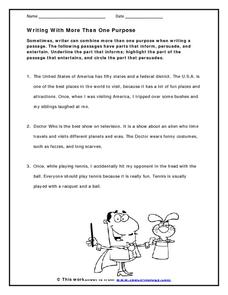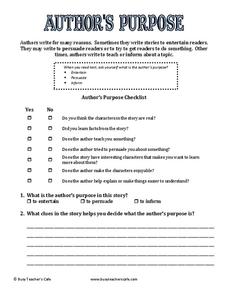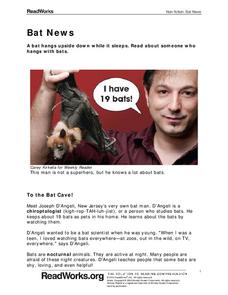Curated OER
Author's Purpose
Find the author's purpose in this review instructional activity. Fourth graders read each of the three following paragraphs and decide whether the author's purpose is to persuade, inform, or entertain. You could use this activity as a...
Teach-nology
Author’s Purpose
What is the author's purpose in writing a joke book? What about a book about the digestive system? Explore author's purpose with a activity that challenges kids to identify whether ten books are meant to entertain, inform, or persuade.
Curated OER
Author's Purpose
Read each of the three short passages and decide whether the author's purpose is to persuade, inform, and entertain. After they have identified the purpose, fourth graders explain why they believe that each passage fits that purpose. You...
Teach-nology
Author’s Purpose: Entertain
How does an author entertain his or her audience? Read a short fairy tale and find the most evocative passages to discover more about author's purpose in narrative writing.
Teach-nology
Author's Purpose
Challenge your class to find the three purposes for writing. After they read three short passages, kids note whether the author's purpose was to inform, persuade, or entertain.
Teach-nology
Author’s Purpose
What is the author's purpose when writing a narrative story? Kids read a short narrative passage before answering three questions about author's purpose.
Teach-nology
Writing with More Than One Purpose
It's not very hard to find the author's purpose in narrative, informative, or persuasive writing, but what happens when an author's purpose includes all three types of writing? Determine which sentences in three paragraphs are meant to...
Teach-nology
The Purpose of Summaries
How can you tell the author's purpose from just a short summary? Kids read three different summaries of books to determine whether the author meant to entertain, persuade, or inform.
Curated OER
Author's Purpose
In this assessing the author's purpose worksheet, students determine whether the author wrote to entertain, persuade, or inform by checking yes and no boxes, identifying the purpose, and listing clues that helped determine the purpose....
Shmoop
ELA.CCSS.ELA-Literacy.RI.9-10.6
What does the author believe about his topic? Why did he write in the first place? Challenge your class to figure out the answers to these questions as they read through informational texts. The resource provides a breakdown of the...
Curated OER
Author's Purpose
In this worksheet on determining the purpose of writing, students read 3 short paragraphs and choose whether they were written to persuade, inform or entertain.
Curated OER
Great Authors Acrostic Poem
In this creative writing instructional activity, students use the letters in AUTHOR to write an acrostic poem. Students write a 6 line poem.
Scholasic
The Magic School Bus and the Missing Tooth
We chew with our teeth every day, but how much do we really know about them? Allow Ms. Frizzle to teach your kids a thing or two about teeth. Kids complete a prereading exercise, read the book, and respond to several prompts about the...
School District of Palm Beach County
Framed Paragraphs characterization, problem and solution, symbolism, conflict
Support your learners as they work on writing paragraphs by providing graphic organizers, outlines, and frames. Sift through this packet to find the perfect organizers and templates to prepare pupils for writing. The resource...
Read Works
Bat News
Get the bat facts with a short nonfiction reading passage. After reading the passage, readers respond to questions that focus on main idea, inferencing, vocabulary in context, and author's purpose.
Arizona Department of Education
Introduction to Integers
Welcome to the backward world of negative numbers. This introductory lesson teaches young mathematicians that negative numbers are simply the opposite of positive numbers as they use number lines to plot and compare...
Baylor College
Tools of Magnification
Life science learners need to be able to use a microscope. With this comprehensive resource, they first experience how lenses and magnification work, and then get familiar with using a compound microscope. Tremendous background...
Shmoop
ELA.CCSS.ELA-Literacy.RL.11-12.3
Identifying an author’s choice, especially choices that concern craft and literary devices, is a difficult skill to teach. Here's an activity that will make your job easier. The resource breaks down how to teach the skill to novice,...
Library of Congress
Determining Point of View: Paul Revere and the Boston Massacre
If you're teaching point of view, this is the lesson for you! First, decipher the writer's point of view from a primary resource, then compare and contrast the primary source with a secondary source to explore the Paul Revere's...
Baylor College
Milestones in Microbiology
Life science learners read a set of six short Discovery Readings that describe historical events in the field of microbiology. For each, they identify clues about when the event occurred and then they try to arrange events in...
Curated OER
Maniac Magee: The Cloze Procedure
Fill in the blanks with a Cloze activity based on Maniac Magee by Jerry Spinelli. After listening to a passage read out loud, kids complete the worksheet by using their memories and context clues.
IPDAE
Themes in Short Stories
"What is the theme of this story?" The very question can spark fear in the minds of readers and incinerate confidence. Here you will discover an exercise that shows how writers use the tools of setting, plot, conflict, and...
Shmoop
ELA.CCSS.ELA-Literacy.RL.11-12.5
What would happen if I structured this review by beginning in the middle of it? Or by flashing back to the dinner I had last night that gave me bad heartburn, and then transitioned into how the lingering burn of acid seeped into my...






















